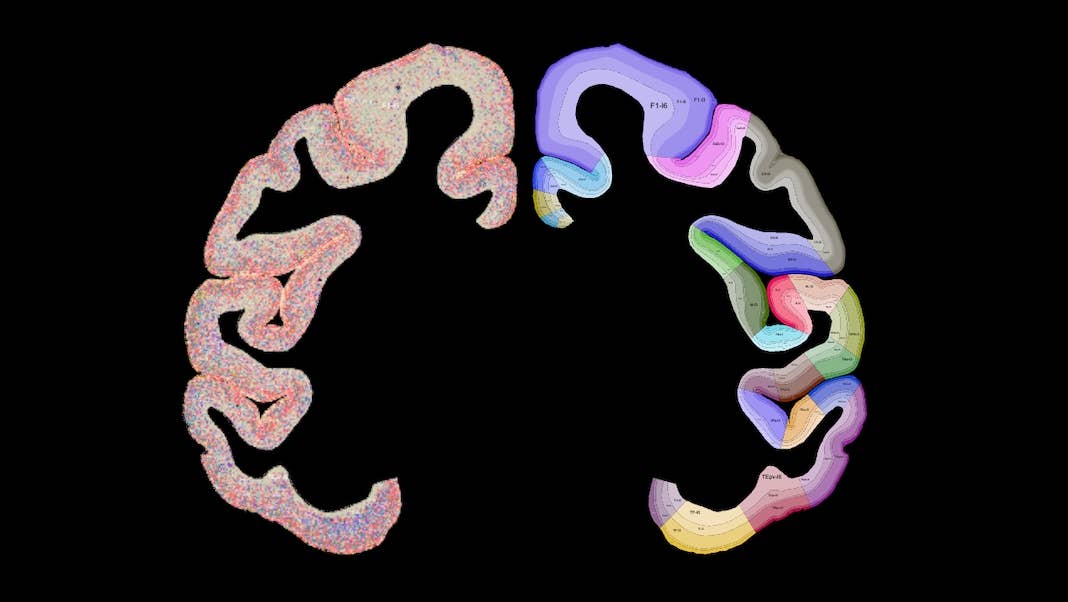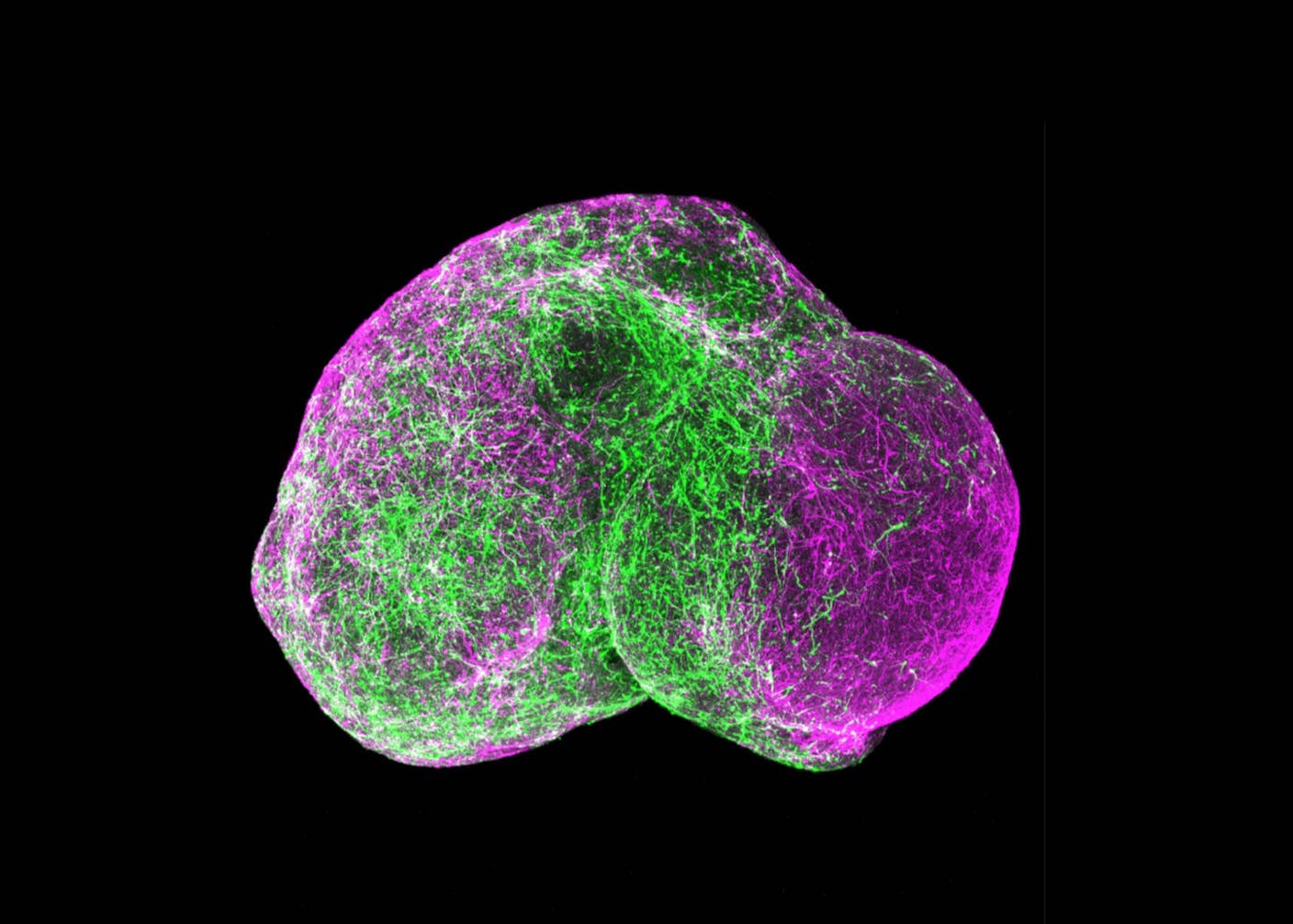Scientists Just Unveiled the Most Complete Map of the Monkey Cortex Yet

Share
An international team led by Chinese scientists just built the most complete atlas of the macaque monkey cortex to date. The outermost layer of the brain, the cortex houses many of our treasured cognitive functions: the ability to reason, make decisions, and adapt to ever-changing environments on the fly.
Compared to other animals, primates—including humans—have a massively expanded cortex. Scientist have long thought this evolutionary quirk is what gives our brains the ability to manage complex computations.
But how?
The secret may be hidden in the cortex’s many cell types and how they organize. A key theme in biology is “structure determines function.” Like building a computer from scratch, each component and its placement and wiring can alter performance.
Cataloging the precise location of every cell in the monkey cortex could help decode—and perhaps digitally recreate—the rules that make the primate cortex a computational powerhouse.
The study, published in Cell, also tapped into a relatively new tool for brain mapping. Called Stereo-seq, the technology extracts genetic information—the transcriptome—from multiple cells at once, adding a new data layer to each cell’s position.
The team created a molecular fingerprint for each cell by recording the activity of roughly 500 genes. Then, thanks to a hefty dose of AI, they categorized nearly 1.5 million cells from 143 regions into distinct cell types and mapped their location in the cortex.
The project has already yielded some insights. Brain cells tend to act in cliques. Some types prefer the company of certain other cells, suggesting they form local neural networks. Neurons that either ramp up or dampen overall brain activity also have preferred spots, with their numbers changing between cortical regions and depth.
Also, when compared to a mouse brain atlas, the new map found several cell types specific to primates huddled together in one layer of the cortex.
"The cell composition of the brain and its spatial distribution are the basic issues of brain science, and its importance is similar to the DNA base sequence discovered by human genome sequencing," said study author Dr. Chengyu Li at the Chinese Academy of Sciences. The macaque cerebral cortex is like ours, and this study offers the most complete map of its kind.
An Enigmatic Neural Cake
The cortex is an elaborate six-layered structure packed with different types of neurons and other brain cells.
Neurons are usually the star of the show: these electrically-activated cells connect into neural networks to process information. The two main types help balance the brain’s overall activity level. Glutamatergic cells are excitatory, ramping up the brain’s computation. GABAergic cells are inhibitory, lowering network activity.
Non-neural cells complete the picture. Some help protect the brain from infections. Others support neural metabolism and clean up molecular waste. They aren’t side characters: recent studies show they play a critical role in the shaping of neural networks in early development and for battling neurodegenerative disorders like Alzheimer’s.
The new study mainly focused on these brain cells.
Slicing and Dicing
The team analyzed brains from three adult male macaque monkeys. With over six billion cells, their brains are evolutionarily close to ours.
To start, the team carefully sliced the brain from front to back with several expert cuts. One, roughly the thickness of printer paper, was used to sequence each cell’s genetic profile.
Be Part of the Future
Sign up to receive top stories about groundbreaking technologies and visionary thinkers from SingularityHub.


Other slices, adjacent to the thicker blocks to maintain spatial integrity, were even thinner. To half of these, the team added a glow-in-the-dark dye that grabs onto proteins dotting the outside of the neurons. This step makes it easy to spot distinct anatomical locations in the cortex.
The second batch of ultra-thin slices had their genetic data extracted by way of the new Stereo-seq tool. Think of this step working like a digital camera, but instead of capturing pixels, it captures gene expression data from each cell in the form of messenger RNA (mRNA). The resulting “transcriptome” is a snapshot of all active genes for any cell at any moment.
The goal here is to image each cell’s transcriptome while maintaining information about each cell’s physical location. Like a camera sensor, the process starts with a silicon chip roughly the size of two stamps. The newly designed chip has a far wider field of view than previous iterations—like a phone on panoramic mode—making it easier to scan larger brain regions.
Dotted on each chip are 2D arrays of DNA nanoballs to grab onto mRNA. Cell membranes were stained with dyes to help the team match a transcriptome fingerprint to its host.
Using multiple AI algorithms, the team mashed all these datasets into the world’s first three-dimensional, single-cell atlas of the macaque cortex. Each cell type is detailed in the map, along with a three-level taxonomy that illustrates how cells differ through the cortex.
For example, a type of excitatory neuron in layers two and three in the cortex expresses a “master regulator” gene for stress signaling in the brain. All three of the brain’s main cells—glutamate, GABA, and non-neuron cells—correlate with the cortex’s structural hierarchy, with some more abundant across its regions and depths.
A Resource for Evolution
The cortex expanded tremendously in primates and is often viewed as the seat of higher cognition. In another analysis, the team compared the monkey brain map to existing mouse and human atlases to dig up new cell types specific to primates.
The test pinpointed a group of excitatory cells in the fourth layer of the primate cortex that are absent in mice. The cells were highly concentrated in the front of the brain—an area supporting higher cognition—with genes previously linked to language, brain development, and autism.
The team made the resource free to anyone. It provides a cornucopia of data for tackling the age-old question of how structure leads to intelligence—and when, why, and how our brains stutter in neurological diseases. Dr. Xun Xu said the results may also “promote breakthroughs in the field of brain science, such as in brain-inspired intelligence and brain-computer interfaces.”
All of the dataset is open source. Play with it here.
Image Credit: Macaque Spatial Transcriptomics Atlas / BGI
Dr. Shelly Xuelai Fan is a neuroscientist-turned-science-writer. She's fascinated with research about the brain, AI, longevity, biotech, and especially their intersection. As a digital nomad, she enjoys exploring new cultures, local foods, and the great outdoors.
Related Articles

How Will the Universe End? The Dark Eternity That Awaits Us Trillions of Years From Now

Five-Year-Old Mini Brains Can Now Mimic a Kindergartener’s Neural Wiring. It’s Time to Talk Ethics.

Are Animals and AI Conscious? Scientists Devise New Theories for How to Test This
What we’re reading